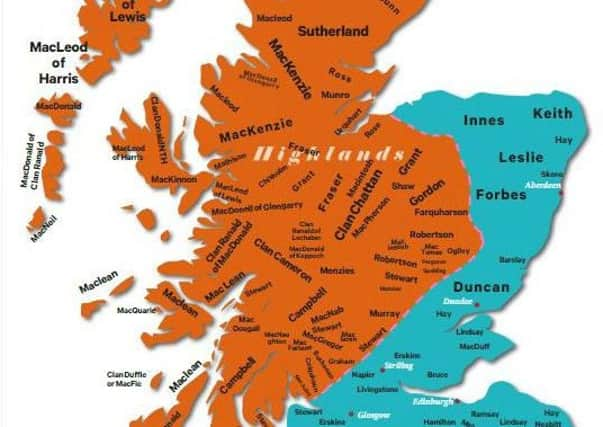Which was the most feared Highland clan?


The stakes were high as the territorial warlords fought for their reputation, wealth and survival against both rival clans and a state sometimes aided by senior clan figures within its fold.
While the clan system offered kinship and security on one level, beheadings and mass graves were also part of the clan story.
But which was the most feared of all the clans?
Advertisement
Hide AdThe answer does not come easily given shifting loyalties and Scotland’s turbulent political and religious landscape.
John Thor Ewing, a writer and historian who is researching the history of his own clan, said clan politics changed “dramatically” over the centuries.
He added: “One of the fascinations of clan history is that each clan has its won history of feuds and alliances, so that one family’s trusty friend is often their neighbour’s treacherous foe.
“Then move forward fifty years, and the situation may be reversed.”
According to Sir Malcolm MacGregor of MacGregor, convener of the Standing Council of Scottish Chiefs, there are a number of possible contenders for the title of the most feared clan.
Number one is Clan Campbell of Breadalbane.
The feud between the MacGregors and the Campbells is well documented but Sir Malcolm said this strand of the Campbells was particularly feared given its dominance over a large swathe of Scotland - and its will to defend it at all cost.
Advertisement
Hide AdSir Malcolm said the Campbells of Breadalbane were “particularly violent”.
He said: “The Earl of Breadalbane was incredibly powerful and held land from coast-to-coast, from the mouth of the River Tay to the Argyll Coast.
Advertisement
Hide Ad“He had huge influence and was determined to hold that land against the MacGregors and others.
“To people like the MacGregors, the clan was incredibly feared and there was a lot of beheading and lynching going on. You wouldn’t want to get captured by the Campbells of Breadalbane.
“That is not to say, however, that the MacGregors didn’t give as good as they got. They were also quite capable of beheadings.”
Sir Colin Campbell, Earl of Breadalbane - known as Grey Colin - personally beheaded the Clan Chief of Gregor on April 7 1750 at Balloch Castle, now the site of Taymouth Castle in Perth and Kinross.
He claimed to hold “the power of pit and gallows” - or the heritable privilege to imprison and execute.
Clan Gregor once held much of Breadalbane territory in Argyll, including Kilchurn at Loch Awe, but it was largely seized by the Campbells after the introduction of feudal tenures by Robert the Bruce.
Advertisement
Hide AdOver time, the Campbells were “very much encouraged by the king” to stamp out people like the MacGregors, Sir Malcolm said.
Sir Duncan Campbell of Glen Orchy had been knighted in 1590 and became instrumental in outlawing the MacGregors in the early 1600s.
Advertisement
Hide AdJohn Campbell, 1st Earl of Breadalbane and Holland, sometimes known as Slippery John, had on behalf of the Crown been involved in negotiations with clan chiefs to accept the rule of King William of Orange.
Following the Massacre of Glencoe in 1692, he was accused of high treason after claims he negotiated a secret deal with the Jacobite supporting clans. He was later released by the King.
Sir Malcolm said that “duplicity, double crossing and theft” was very much part of the story of Highland clans.
“And the Campbells were very good at it,” Sir Malcolm added.
Seafaring clans also had their place among the most feared of the territorial warlords.
MacDonalds of the Isles, for example, were “not to be messed with,” Sir Malcolm claimed.
Advertisement
Hide AdThis strand of the MacDonalds, who have been described as a band of “independent princes”, were not subject to the Scottish king and ruledthe Hebrides, Skye and Ross, Knoydart and Ardnarmuchan as well as pockets of mainland at their height.
At one time, they were the largest landowners in Scotland.
The clan struck at treaty with Edward III of England in 1338 with the last leader, John of Islay (1434-1503), becoming embroiled in a dangerous plot to aid an invasion of mainland Scotland. It was to be the downfall of the clan.
Advertisement
Hide AdAnother seafaring clan, The MacNeils of Barra, were also a law unto themselves. Notorious pirates, they exploited their superb knowledge of the sea and survived chiefly on the rewards of their water borne raids.
MacNeils attacked from their base of Kismul Castle in Birlinn vessels, which were very similar to the Viking long boats.
Indeed, recent DNA testing on the MacNeils proved the Norse lineage of the clan and discounted the long held theory that the clan descended from an 11th Century Irish prince.
Sir Malcolm said the Border clans - such as the Armstrongs and the Elliots - should also be remembered given their role in fighting the English over the “debatable lands.”
Johnnie Armstrong of Gilnockie was once one of the most popular, powerful, and feared clan chiefs in the Scottish borders.
In 1530, he and around 30 to 40 of his men, were was executed after being ambushed by James V’s army at Carlienrig.
Advertisement
Hide AdThey had been en route to meet the King - and therefore unarmed - when they encountered the King’s men.
They were all taken out and hanged from the trees, and then buried in a mass, unmarked grave.
“The King was really as violent as anyone else,” Sir Malcolm said.